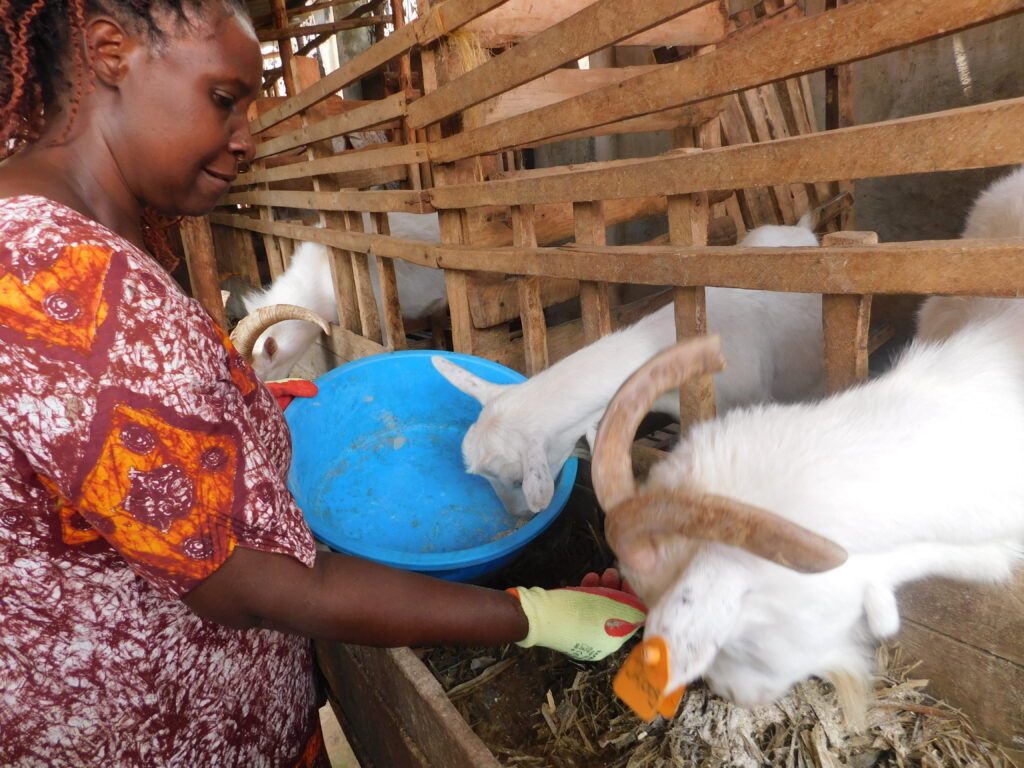By Joshua Kato
Juliet Kanyesigye likes goats. However, she loves milk goats even more! This is because while other farmers keep goats for meat, she keeps her goats for milk. And while most farmers simply drink the milk, she processes her milk into several products
including lotions and medicinal soaps.
In Luwafu, Makindye division , Kampala, she keeps a herd of clean, white goats under a zero grazing system. They munch away at fermented grasses, commonly known as silage. The white goats are housed in wooden/timber structures fixed inside part of a bungalow. The structures are raised by at least a foot off the ground.
“We started the dairy goat’s farm in 2018,” says Juliet Kanyesigye. The urban farm now has 18 goats. Kanyesigye bought each goat at sh1m. “These are Sanen breeds. They are not so common in Uganda, however I decided to keep them because I wanted something unique. I wanted more than just milk,” she says.
During the 2024 Harvest Money expo, that will be held at Kololo Ceremonial grounds, Kanyesigye will facilitate a session on managing goat’s milk in addition to processing the milk into various products.
The expo is organised by Vision Group in partnership with the Embassy of the Netherlands. It is sponsored by Tunga Nutrition who are producers of livestock feeds concentrates, Engineering Solutions who deal in farm machinery like tractors, The
National Agricultural Advisory Services (NAADS), Korea Agri-business Innovation Centre-K-abic- and Technoserve.
Although goats produce a small amount of milk compared to cattle, Kanyesigye will show farmers how it is far more valuable. She has been practicing this enterprise for several years now, so she will be sharing her experience with the farmers.
“Each of the goats yields one litre on average per day,” she says. Out of the 18 goats, 10 are milking while the others are in gestation.
This is a purely zero grazing enterprise which means that the goats have to be directly fed because they cannot move out to scavenge for feeds. She explains that she picked zero grazing because this enables her calculate how much they have eaten.
“We feed them on silage and brewers’ waste,” she says. Each of the goats is also given at least 20 litres of water per day because this helps them increase milk production,” she says.
To keep away diseases, the goat`s shelter are kept clean.

Goats in Uganda
According to the Ministry of Agriculture Animal Industry and Fisheries (MAAIF), there are about 16million goats in Uganda. For ordinary goats, farmers mainly keep the Mubende and Small East African, crossed with either Boer or Savannah. According to Edgar Muhumuza, a goat farmer who will also train general goat management at the expo, Mubende crossed with either boer or savannah produces an offspring that grows faster and heavier.
“There is enough market for goats products in the country and abroad. It is a matter of us goat farmers organising ourselves so that we produce enough to satisfy these markets,” Muhumuza says.
For milk goats, the commonest are the sanen and toggenburg breeds. This is because compared to ordinary breeds, they produce more milk.
Deciding to add value
According to Kanyesigye, dairy goats were first introduced in Uganda in the early 90s by NGOs that were at the time supporting people living with HIV.
Goat milk is perhaps the best milk after human milk, according to Dr Imelda Kasolo. “It is a source protein, calcium, potassium, magnesium and vitamins. It can be used as a feeding supplementary for severely malnourished patients,” she says.
The milk can also be used as a supplementary feed for malnourished people.
Kanyesigye’s foray into value addition started during the COVID-19-induced lockdown to manage the spread of the disease.
“We had a lot of milk and yet movement was restricted. I had to find a way of increasing its shelf life,” she says.
She did research and realised goat milk had lots of benefits. For example, it can be directly used to cleanse the skin because the skin membrane is made up of selenium which are present in goats milk, she says.
Value addition stood out and she employed the services of a professional chemist. The formulas were done by a professional chemist. “We did so many tests until we came up with the best combination. Our soap and lotion has fatty acids that help repair the skin barrier to encourage growth of normal skin,” she says. Other ingredients involved in processing include palm kernel oil, coconut oil and lemon perfume.
High earnings
Kanyesigye will explain that when she processes the milk, earnings go higher than if she had sold it raw. A litre of fresh milk goes for sh9,000. To process 500 pieces of soap, Kanyes uses 45 litres of milk. Each of the pieces goes for sh15,000. This means
that Kanyes gets a gross of sh7.5m from 45 litres of milk. On the other hand, if she had sold the milk raw, she would have earned about sh400,000. “Of course, the other ingredients that I add account for about 30% of the production costs, but still it makes more money to add value to the milk than selling it raw,” she says.





